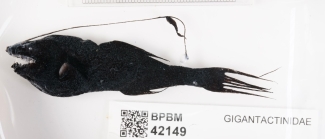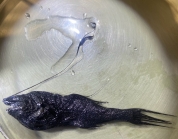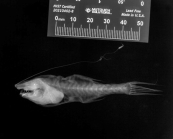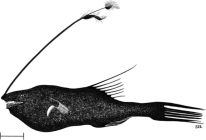WoRMS taxon details
Gigantactis paresca Rickle, 2024
1796972 (urn:lsid:marinespecies.org:taxname:1796972)
accepted
Species
marine, fresh, terrestrial
Rickle, S. Z. (2024). A New Species of the Anglerfish Genus Gigantactis (Lophiiformes: Ceratioidei) from the Clarion Clipperton Zone of the Eastern North Pacific Ocean, an Ecosystem Threatened by Deep-Sea Mining. <em>Ichthyology & Herpetology.</em> 112(2)., available online at https://doi.org/10.1643/i2023056 [details] Available for editors  [request]
[request]
Holotype BPBM 42149, geounit Clarion Clipperton Zone
Holotype BPBM 42149, geounit Clarion Clipperton Zone [details]
Description Illicium without filaments until emergence of secondary illicial appendage. Escal bulb itself spherical in shape, covered...
Distribution Gigantactis paresca is known only from the holotype collected in the eastern North Pacific in an open midwater trawl with a...
Etymology From the Latin par, meaning pair, and esca, meaning bait, referring to the pair of baited appendages on the lure.
Description Illicium without filaments until emergence of secondary illicial appendage. Escal bulb itself spherical in shape, covered with many fine filaments. Contains distal prolongation that emerges from proximal end of esca, about 2–2.5 times as long as width of esca. Escal appendage darkly pigmented along proximal half and contains white spots, though it is unclear whether these spots occurred naturally or if damage occurred during collection. Distal half of escal appendage unpigmented and contains a distal prolongation. Entire surface of illicium darkly pigmented, except for esca and filaments. Number of teeth on right premaxilla 14; right side of inner cluster of larger vomer-type teeth 7; on right dentary 25. Dorsal-fin rays 7; anal-fin rays 6; pectoral-fin rays 17; caudal-fin rays 9. Second and seventh caudal rays nearly equal in length (about 33% SL); third, fourth, fifth, sixth, and eighth approximately equal (about 30% SL), though it is possible that eighth ray is broken and should be closer in length to first. Ninth ray short and could only be seen through x-ray imaging. [details]
Distribution Gigantactis paresca is known only from the holotype collected in the eastern North Pacific in an open midwater trawl with a...
Distribution Gigantactis paresca is known only from the holotype collected in the eastern North Pacific in an open midwater trawl with a primary fishing depth between 699–1,002 m. There are no known recorded males. [details]
Etymology From the Latin par, meaning pair, and esca, meaning bait, referring to the pair of baited appendages on the lure.
Etymology From the Latin par, meaning pair, and esca, meaning bait, referring to the pair of baited appendages on the lure. [details]
Froese, R. and D. Pauly. Editors. (2025). FishBase. Gigantactis paresca Rickle, 2024. Accessed through: World Register of Marine Species at: https://marinespecies.org/aphia.php?p=taxdetails&id=1796972 on 2025-05-03
Date
action
by
![]() The webpage text is licensed under a Creative Commons
Attribution-Noncommercial 4.0 License
The webpage text is licensed under a Creative Commons
Attribution-Noncommercial 4.0 License
Nomenclature
original description
Rickle, S. Z. (2024). A New Species of the Anglerfish Genus Gigantactis (Lophiiformes: Ceratioidei) from the Clarion Clipperton Zone of the Eastern North Pacific Ocean, an Ecosystem Threatened by Deep-Sea Mining. <em>Ichthyology & Herpetology.</em> 112(2)., available online at https://doi.org/10.1643/i2023056 [details] Available for editors  [request]
[request]
basis of record Froese, R. & D. Pauly (Editors). (2025). FishBase. World Wide Web electronic publication. version (06/2024)., available online at https://www.fishbase.org [details]
basis of record Froese, R. & D. Pauly (Editors). (2025). FishBase. World Wide Web electronic publication. version (06/2024)., available online at https://www.fishbase.org [details]
 Present
Present  Present in aphia/obis/gbif/idigbio
Present in aphia/obis/gbif/idigbio  Inaccurate
Inaccurate  Introduced: alien
Introduced: alien  Containing type locality
Containing type locality
Holotype BPBM 42149, geounit Clarion Clipperton Zone [details]
From editor or global species database
Description Illicium without filaments until emergence of secondary illicial appendage. Escal bulb itself spherical in shape, covered with many fine filaments. Contains distal prolongation that emerges from proximal end of esca, about 2–2.5 times as long as width of esca. Escal appendage darkly pigmented along proximal half and contains white spots, though it is unclear whether these spots occurred naturally or if damage occurred during collection. Distal half of escal appendage unpigmented and contains a distal prolongation. Entire surface of illicium darkly pigmented, except for esca and filaments. Number of teeth on right premaxilla 14; right side of inner cluster of larger vomer-type teeth 7; on right dentary 25. Dorsal-fin rays 7; anal-fin rays 6; pectoral-fin rays 17; caudal-fin rays 9. Second and seventh caudal rays nearly equal in length (about 33% SL); third, fourth, fifth, sixth, and eighth approximately equal (about 30% SL), though it is possible that eighth ray is broken and should be closer in length to first. Ninth ray short and could only be seen through x-ray imaging. [details]Diagnosis Metamorphosed females of G. paresca differ from others of the genus in having the following combination of characters: illicium relatively short (100–110% SL); enlarged non-light-bearing secondary esca approximately 75% from the insertion of the illicium, scarcely covered in fine filaments concentrated at the base and tip of the appendage; dentary teeth moderate (longest tooth 3.8% SL), arranged in approximately three distinct longitudinal series with numerous additional teeth scattered between rows; longest caudal-fin ray 35.8% SL. [details]
Distribution Gigantactis paresca is known only from the holotype collected in the eastern North Pacific in an open midwater trawl with a primary fishing depth between 699–1,002 m. There are no known recorded males. [details]
Etymology From the Latin par, meaning pair, and esca, meaning bait, referring to the pair of baited appendages on the lure. [details]
Holotype BPBM 42149, single metamorphosed female, 65.7 mm, DeepGreen 5C, Clarion-Clipperton Fracture Zone, NORI-D Claim Zone, MOCNESS trawl, Eastern North Pacific, 10852014.900N, 116816037.900W–10850051.100N, 116816040.100W, 699–1,001.8m, 5 October 2021. [details]
| Language | Name | |
|---|---|---|
| English | paired-lure anglerfish | [details] |




